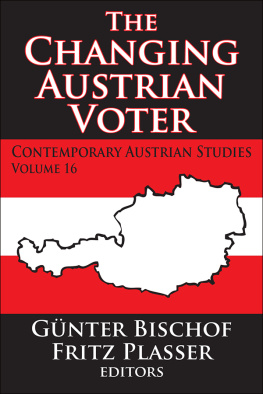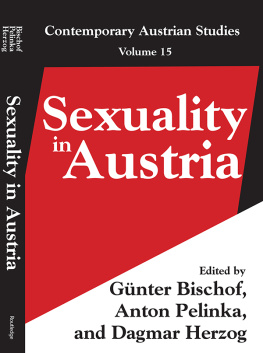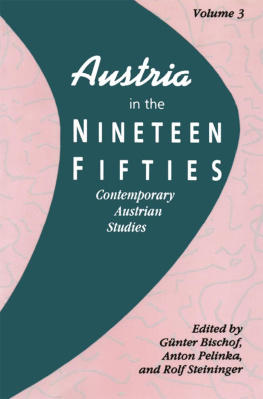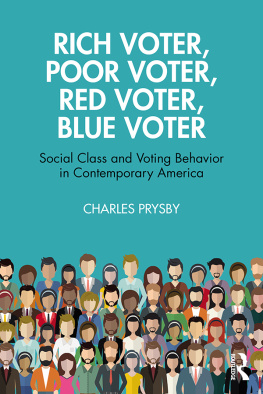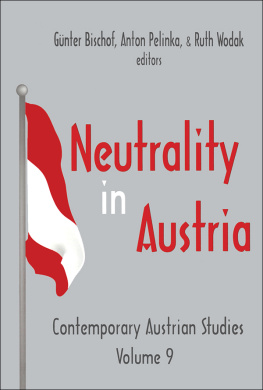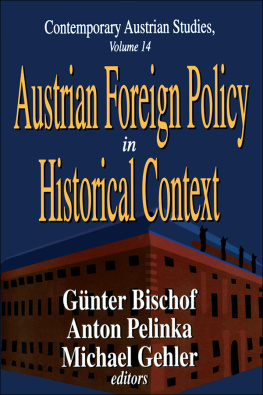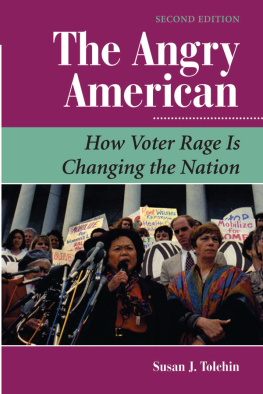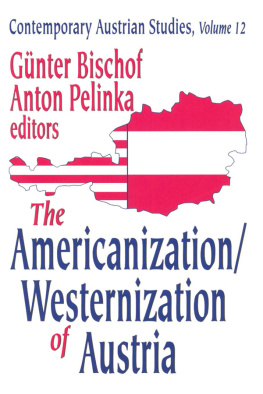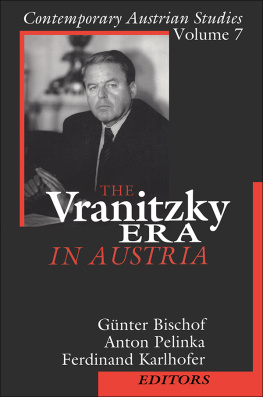THE CHANGING AUSTRIAN VOTER
THE CHANGING AUSTRIAN VOTER
CONTEMPORARY AUSTRIAN STUDIES, VOLUME. 16
GNTER BISCHOF FRITZ PLASSER
EDITORS
First published 2008 by Transaction Publishers
Published 2017 by Routledge
2 Park Square, Milton Park, Abingdon, Oxon OX14 4RN
711 Third Avenue, New York, NY 10017, USA
Routledge is an imprint of the Taylor & Francis Group, an informa business
Copyright 2008 by Taylor & Francis.
All rights reserved. No part of this book may be reprinted or reproduced or utilised in any form or by any electronic, mechanical, or other means, now known or hereafter invented, including photocopying and recording, or in any information storage or retrieval system, without permission in writing from the publishers.
Notice:
Product or corporate names may be trademarks or registered trademarks, and are used only for identification and explanation without intent to infringe.
Library of Congress Catalog Number: 2007051037
Library of Congress Cataloging-in-Publication Data
Bischof, Gnter, 1953-
The changing Austrian voter / Gunter Bischof and Fritz Plasser.
p. cm.(Contemporary Austrian studies, vol. 16)
Includes bibliographical references and index.
ISBN 978-1-4128-0751-7
1. ElectionsAustriaHistory20th century. 2. ElectionsAustriaHistory21st century. I. Plasser, Fritz, 1948- II. Title.
JN2029.B57 2008
324.9436dc22
2007051037
ISBN 13: 978-1-4128-0751-7 (pbk)
Table of Contents
FORUM
Austrian Experts Interpret the National Elections of October 1, 2006
NON-TOPICAL ESSAYS
Peter Ruggenthaler, A New Perspective from Moscow Archives: Austria and the Stalin Notes of 1952
REVIEW ESSAYS
Matthew Paul Berg, Refocusing the Critical Gaze from Sixty Years Distance: Austrians Experiences of the Nazi Past in Recent Historical Studies
BOOK REVIEWS
Thomas Nowotny: Michael Gehler, sterreichs Aussenpolitik der Zweiten Republikvon der alliierten Besatzung bis zum Europa des 21. Jahrhunderts, 2 vols. (Innsbruck: Studienverlag, 2005)
ANNUAL REVIEW
Reinhold Grtner, Austria 2006
Contemporary Austrian Studies
Sponsored by the University of New Orleans and Universitiit Innsbruck
Editors
Gnter Bischof, CenterAustria, University of New Orleans
Anton Pelinka, University of Innsbruck
Production Editor Ellen Palli
Copy Editor Jennifer Shimek
Assistant Editor Josef Kostlbauer
Executive Editors Franz Mathis, UNO Coordinator, University of Innsbruck
Robert L. Dupont, Dean, Metropolitan College
Advisory Board
Ingrid Bauer
University of Salzburg
Siegfried Beer
University of Graz
Evan Bukey
University of Arkansas, Fayetteville
Mario Caciagli
University of Florence
Gary Cohen
Center for Austrian Studies
University of Minnesota
Christine Day
University of New Orleans
Wilhelm Kohler
Tbingen University
Jacques Le Rider
University of Paris VIII
Kurt Richard Luther
University of Keele
Andrei S. Markovits
University of Michigan, Ann Arbor
Margareta Mommsen
University of Munich
Hanspeter Neuhold
University of Vienna
Max Preglau
University of Innsbruck
Sonja Puntscher Riekmann
University of Salzburg
Peter Pulzer
Oxford University
Oliver Rathkolb
University of Vienna
Sieglinde Rosenberger
University of Vienna
Dieter Stiefel
University of Vienna
Franz Szabo
Center for Austrian Studies,
University of Albel1a
Ruth Wodak
University of Lancaster
Publication of this volume has been made possible through one time generous post-Hurricane KaIrina grants by the Austrian Ministry of Science and Research as well as the Austrian Ministry of Foreign Affairs through the Austrian Cultural Forum in New York. The Austrian Marshall Plan Anniversary Foundation in Vienna has also supponed the production of this volume. Metropolitan College al the University of New Orleans and the AlIslalldsaml of the University oflnnsbruck have provided additional financial support. The University of Chicago Press has gramed pennission to reprint David Lufts lead essay.
The Changing Austrian Voter
Fritz Plasser and Gnter Bischof
Structural changes in voting behavior are an indicator for social change and societal modernization. In fact, in the course of the last thirty years, with regard to educational and occupational structures, the Austrian electorate developed from a primarily industrially-oriented electorate toward a post-industrial information- and service-oriented one.
In the National Election of 1975, only 3 percent voted for another party than they had voted for in the previous election; in 2006 there was a whopping 26 percent of party changers. This was the highest change rate in Austrian elections to date. It shows how much Austrian voting behavior has approached the European mainstream. For example, 28 percent of the voters changed their party at the German parliamentary election of 2005. During the Swedish parliamentary election of 2006, there were 30 percent party changers. Within thirty years, a segmented, party-loyal, Lager electorate turned into a highly mobile, issue-driven electorate. In Austria as in the rest of Europe, no longer do traditional party loyalties but competence of parties on issue count first and foremost.
The erosion of stable party affiliations has simultaneously affected the rate of voting participation. While thirty years ago voter turnout rates still remained constantly above 90 percent, Austriathird behind Italy and Belgiumwas, comparatively speaking, among the countries with the highest rates of voter turnout; however, in the 1980s voting participation progressively declined. In 2006, only 78.5 percent participated in the national electionsthe lowest voter turnout at national elections so far. In voter participation rates, Austria clearly is approaching the European average, too. In neighboring Germany, with only 77.7 percent of the population voting, the turnout rate at the Parliamentary Elections of 2005 also reached an historical low. Similar declines of voter turnout could also be observed at the recent parliamentary elections in Italy, the United Kingdom, and Sweden. In all of these countries, participation in electionsespecially among the younger generation of votersis not seen as a civic duty anymore. Reasons for declining voter turnout, however, are not only found in traditional political participation repertoires, but also in an increased readiness of politically disappointed and/or annoyed voters to express their protest by demonstrative voting abstinence.
To abstain from casting ballots is only one of several options for angry voters. Angry voters can be directly approached and mobilized by protest parties. Besides the exit-


